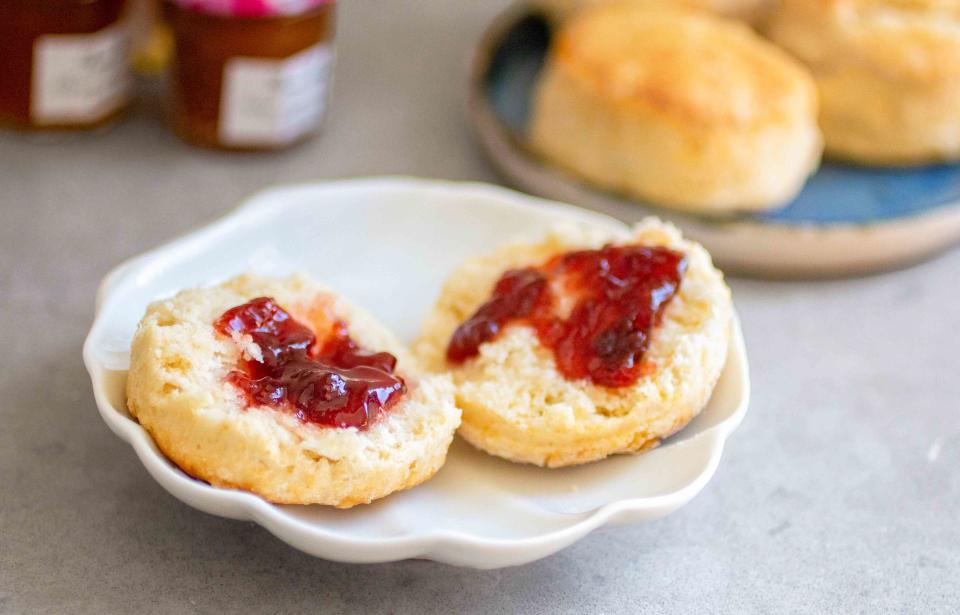200 Thousand of This Popular British Tea Time Favorite Are Served Every Year—I Tried the Recipe
You probably have all the ingredients on hand.

Simply Recipes / Erika Kwee
There’s something about the crumbly, not-too-sweet, almost bready texture of scones that I vibe with, even if it’s just a Trader Joe’s scone heated up in the toaster oven.
I’ve spent a lot of time thinking about how to make the best scones, testing all-cream variations vs. all-butter scones as well as hybrid cream and butter recipes. So when I found out about the famous tea time scones served at Claridge’s, a Mayfair hotel in London (with more than 210,000 scones sold every year!), I had to try the recipe.
How British and American Scones Differ
Claridge’s recipe is butter-based, enriched with milk and buttermilk. This recipe's relatively lower proportion of fat reflects the typical difference between British and American scones.
While American scones have a higher proportion of butter and sugar for a richer, sweeter flavor and denser texture, British scones typically contain less butter for a breadier and lighter texture. They’re also generally less sweet, designed to be adorned with clotted cream and jam. (Note: The Devon way to properly eat a scone is to start with the cream, while the Cornish way is to add the jam first.)
Claridge’s legendary afternoon tea starts with finger sandwiches followed by pastries and tiny buttery scones served alongside Cornish clotted cream and Marco Polo tea gelée.
Claridge’s offers two options: plain or raisin scones. Either way, these breads are little buttery delights!

Simply Recipes / Erika Kwee
How To Make Claridge’s British Scones
Luckily, the recipe for these famous scones calls for basic baking ingredients that you probably already have in your kitchen: flour, sugar, baking powder, salt, butter, buttermilk, milk, and egg.
Unlike most American scone recipes I’ve tried, the Claridge’s recipe calls for an unusual step: rubbing the butter into the dry ingredients until you have a fine crumb and then refrigerating the mixture overnight or until thoroughly chilled.
Once the butter mixture is chilled, you’ll use a stand mixer to incorporate the buttermilk and milk until combined. My dough looked quite smooth and almost pasty once I was done incorporating the liquid—a far cry from the coarser texture you generally want to see in an American-style scone dough.
From there, you’ll simply roll out the dough and cut out 12 two-inch biscuits. Brush with egg wash and leave the scones out at room temperature for 20 minutes to allow the baking powder to activate (this is a good time to preheat your oven). These scones are best served fresh and warm out of the oven!
I served some to my travel and pastry expert friend, Jenn Yee, and she approved! “I love the way these are slightly sweet with a tender, finer crumb vs. the more buttery, flakier, heftier American-style scones. The delicate sweetness is a perfect vehicle for clotted cream and jam!”

John Carey
Tips for Making Scones
Use a glass for stamping out the scones: If you don’t have a two-inch pastry or biscuit cutter, you can make do with a glass or mason jar around the same size.
Granulated sugar works as a swap: If you don’t have caster sugar on hand, regular granulated works just as well.
Make your own buttermilk: If you don’t have buttermilk, you can substitute a 1:1 mixture of plain yogurt or sour cream and milk.
Nix the mixer: Although the recipe calls for a stand mixer to incorporate the milks, you can easily do this by hand and without using any special mixing equipment.
Skip the overnight wait: If you didn’t have the foresight to make the butter mixture the day before you want to eat these scones, stick the mixture in the freezer for 20-30 minutes, or until thoroughly chilled.
Get Recipe with Title: Claridge’s Scones
Read the original article on Simply Recipes.

 Yahoo Lifestyle
Yahoo Lifestyle 
